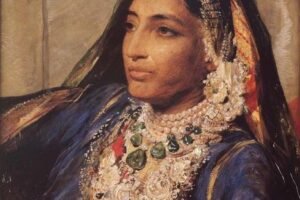The tercentenary event is being held to commemorate the long cherished history of Sikhs and to reaffirm, rejoice and rejuvenate the global Sikh community. This event will involve remembrance of the 300th year of consecration of the Holy Scripture of the Sikhs, Guru Granth Sahib, as the eternally steady Master Guru of the entire world in general and the Sikh community in particular Guru Gobind Singh.
Guru Gobind Singh in 1708 at Nanded, ordained that Guru Granth Sahib was henceforth to be the Eternal Guru, thus ending the line of physical Gurus. The tenth Master believed that humans are fallible but noble ideas live forever. Guru Granth Sahib is the fountain-head of universal wisdom, containing hymns of six Gurus and various Sants, Bhagats, Sufis and Bhatts, covering a period of five centuries from the 12th to 17th. This Holy Scripture is a remarkable storehouse of spiritual knowledge and teachings that do not preach any rites or rituals. With devotional hymns and prayers to the Supreme, it lights the path to spirituality.
Guru Gobind Singh ordained that hereafter, there would be no mortal Guru for the Sikhs. Instead, they would follow the teachings of Guru Granth Sahib, the consecration of which as the Eternal Guru is called Gurta-Gaddi.
The making of the Eternal Guru
It was in October 1708 that the tenth Guru, Gobind Singh, elevated Guru Granth Sahib as the Eternal Guru at Nanded in Maharashtra and discontinued the tradition of the succession of human Gurus.
How Sri Guru Granth Sahib is the Guru?
‘Sabh Sikhan Ko Hukam Hai, Guru Maneyo Granth‘ (Guru Gobind Singh)
(This is the edict for all the Sikhs; accept the Granth as the Guru)
This edict of the tenth Master makes it easy for the Sikh to answer the question of Guru Granth Sahib being the Guru. For him it is the tenth Guru’s edict or Hukam. Gurbani speaks strongly against idol worship and other rituals practiced in the Hindu faith. We have to have vision of the Shabad through reading and contemplation and not just by looking at it. The salvation cannot be attained without the Guru’s grace, faith and good deeds.
Guru Granth Sahib is the only scripture amongst those of all religions that has the status of the Guru. This status was given to the scripture by the tenth Guru, Gobind Singh before he merged with the Divine light:
Agyaa bhaee Akaal kee tabhi chalaayo Panth Sab Sikhan ko hukam hai Guru maanyo Granth. Guru Granth Ji maanyo pragat Guran ki deh Jo Prabh ko milbo chaahe khoj sabad meinh leh
(The Eternal Father willed and I raised the Panth. All my Sikhs are hereby ordained to accept the Granth as their Preceptor. Have faith in the holy Granth as your Master and consider it the visible manifestation of the Gurus. He who has a pure heart will seek guidance from its Holy words.)
These are the words uttered by Guru Gobind Singh, before he shed his mortal frame on October 7, 1708, at Nanded to end the physical Guruship and declared Guru Granth Sahib as the Guru Eternal. He proclaimed that the temporal functions of the Guru will be performed by the Panj Pyaras (the five beloved ones), whereas the spiritual guidance will be provided by Guru Granth Sahib. “Whosoever wishes to behold God, let him search Him in Guru Granth Sahib….Where ever five Amritdhari Sikhs are assembled together, there I will be present”. Agyaa bhaee Akaal kee, the last sermon of Guru Gobind Singh did not anoint any human successor in the line of human Guruship as per tradition.
The Guru declared Granth Sahib to be the ultimate preceptor and the Guru Eternal for the Sikhs. He bestowed Guruship on Granth Sahib at Hazur Sahib by circumambulating five times and bowing his head before it. He declared that after him, the living Guru would be embodied in the Shabad (‘Word’) as contained in Guru Granth Sahib. Guru Gobind Singh affirmed the sacred text as his successor, terminating the line of human Gurus and elevating the text to Guru Granth Sahib.
Sikh Gurus in human form between 1469 – 1708 guided Sikhs to recognize the unity of mankind on our planet and the Fatherhood of God in the entire universe. Guru Granth Sahib embodies revelations of Sikh Gurus, saints, seers and visionaries, who stress enshrining God’s Name in the centre of consciousness as the sure way to peace. In 1708, Guru Gobind Singh ordained Sikhs to seek guidance only from the Shabad in the sacred scriptures, thus ending the possibility of any human gaining the status of Sikh Guru.
300 years down the line, we are in the process of Gurta-Gaddi celebrations. It is time for retrospection and introspection – whether we are following what the Guru ordained. If not, this great event gives us the opportunity to start life afresh, as the Guru’s poet laureate Bhai Nand Lal says:
Aag-ai samajh chalo Nand Lala Paachhai jo beetee so beetee
The Guru, as explained elsewhere, is a multi-dimensional term. Of its many etymologies, that which accords well with Guru Nanak’s thought and is accepted by the Sikh savants is gu ‘darkness’, and ru ‘light’. Put together, the word Guru so formed means one who leads people from darkness to light; from the unreal to the real, and from death to immortality. This the Gurus may do by imparting unto the people their message based on some religious authority, e.g., the Vedas, the Bhagavad Gita or any other sacred text. Yet there may be Gurus who base their message on their personal experience—people like themselves have had the divine vision and can lead others to the realization of that vision. Such people are very much respected and are greatly sought after. It is men of such stature as come to be known as prophets and messengers of God. The Sikh Gurus fall in the last category. Whatever they taught was the result of their personal experience and direct communion with the Spirit Divine.
The Guru is a multi-dimensional term. Of its many etymologies, that which accords well with Guru Nanak’s thought and is accepted by the Sikh savants is gu ‘darkness’, and ru ‘light’. Put together, the word Guru so formed means one who leads people from darkness to light; from the unreal to the real, and from death to immortality.
Ãsã di Vãr is replete with directions to the seekers to seek the blessings of the Guru in their journey from the phenomenal world to the ‘Abode Eternal’. The opening Sloka pays rich tributes to the Guru, who could, if he so wished, turn mortal human beings into angels – that too just in a trice. The next Sloka stresses the indispensability of the Guru who alone can dispel the darkness of nescience. The injunction does not end here. It finds repetition, burden-like, at many other places too:
Satgur miliai sach paa-i-aa, Jin ke hirday sach wasaa-i-aa (467)
(Truth may be imbibed only through initiation by the True Guru; For, it is he, in whose heart Thou, O Lord, hast planted Truth.)
Satgur bhetai so sukh paa-i-e (467)
(One who seeks guidance of the True Guru alone finds peace and happiness.)
Gian kaa badhaa mann rah-i-e Gur bin gian naa hoey (469)
(Knowledge Divine disciplines the human mind. But knowledge itself may not be had save through the aegis of the Guru – the Enlightener.)
Satguru hai bohithaa (470)
(The True Guru is the raft, that may ferry one across the ocean of life.)
Kahau Nanak nihchao dhiaavai Vinn Satgur waat naa paavai (470)
(With purity of mind and heart, 0 Nanak, need one pray to the Lord. And for the right path one need to look up to the True Guru.)
Apart from injunctions culled from Slokas and Pauris quoted above, two Pauris (IV and VI) of Var proper, deal solely with the status and function of the Guru. The first of these Pauris states that the benevolent Lord’s grace being descending on one, one may be led on to the True Guru, who may mercifully initiate one into the Divine Lore. Indeed, it is only after meandering through many a life that one is blessed with a word from the lips of such a Teacher:
Satgur jevad daataa ko nahee sabh suneyo lok sabhaa-i-aa Satgur miliai sach paa-i-aa jinee wichahau aap gavaa-i-aa Jin sacho sach bujhaa-i-aa (465)
(Listen to ye people, no being is as benevolent as the True Teacher. The True Guru alone through his benign grace may expel one’s ego and help one realize Truth Absolute.)
The other Pauri (VI) warns:
Bin Satgur kine naa paa-i-o bin satgur kine naa paa-i-a Satgur wich aap rakhiaun kar pargat aakh sunaa-i-aa Satgur miliye sadaa mukt hai jin witchau moh chukaaia (466)
(Without recourse to the True Teacher, no one has ever got anywhere near God. God himself radiates His Essence to the True Guru. Treading the path shown by him, indeed, brings one close to salvation. This, the Guru does by getting his disciple rid of all infatuations for things mundane.)
With this stress on the Guru by the first Master himself, a question arises as to who the Satguru referred to in Pauris above could be? It could not be Guru Nanak himself for that status has nowhere been assumed by the Guru in his Baani. At the most, he had proclaimed himself to be a Dhadi (bard) engaged in singing Lord-God’s praises and in spreading the Lord’s message.
Alternatively, it could be a reference to Guru Nanak’s own teacher – if there was any. This possibility stands negated, for Guru Nanak has nowhere referred to his teacher. In fact, it is a queer mystery that stalwarts of the Sant tradition – Namdev, Kabir and Guru Nanak – have nowhere disclosed the names
of their preceptors. It would, as a distinguished writer says, “be illogical to expect these Sants to have human gurus, for one of the greatest stresses in their Sampradaya (orders) was upon the immanence of the Divine and self-disclosure of God”—in plain words, the transmission of the message direct by the Lord through them. All of them claim to have a direct vision of God at one or the other stage of their lives. One of Guru Nanak’s hymns is very revealing in this respect. It recalls how he, an unemployed minstrel, was one day summoned into Lord God’s presence, offered a cup of nectar to drink and then sent back to preach the Lord’s Word:
Dhaadee sachai mahal khasam bulaa-i-aa. Sachee sifat saalaah kaprhaa paa-i-aa. Sachaa amrit naam bhojan aa-i-aa. Gurmatee khaadhaa raj tin sukh paa-i-aa. Dhaadee karay pasaa-o sabad vajaa-i-aa. (150)
(My Lord and Master has summoned me, His minstrel, to the True Mansion of His Presence. He has dressed me in the robes of His True Praise and Glory. The Ambrosial Nectar of the True Name has become my food. Those who follow the Guru’s Teachings, who eat this food and are satisfied, find peace. His minstrel spreads His Glory, singing and vibrating the Word of His Shabad.)
The inspiration in this case thus came direct from God, and from no human teacher. The fifth Master, Guru Arjan, vouchsafes this fact in a hymn by declaring that Guru Nanak has had, as his teacher, the Infinite Lord himself:
Aprampar paarbarahm parmesar Nanak gur mili-aa so-ee jee-o. (599)
(The Infinite Transcendent Lord, the Supreme Lord God Nanak has met with Him, the Guru.)
Should the reference in Ãsã di Vãr be attributed to Guru Nanak’s preceptor, that would mean God Himself; and this is what certain expositors of Gurbani mean when they equate Satguru with God.
This view when examined minutely suffers from one inconsistency. There are verses, as quoted above, in which the Guru and God, both, figure as separate entities. For example, the following:
Satgur vittahau war-i-aa, Jitt mili-a-i khasam samal-iaa (470)
(May I be a sacrifice unto my Guru, whose grace has inducted me to the Spirit Divine.)
Here the Guru and the Spirit Divine (Khasam) are clearly two separate entities. Guru Arjan too treats them as separate entities. In one of his hymns he states that the True Teacher is one who has realized the Truthful Lord. It is but in such a one’s company that I, Nanak, have been liberated, singing God’s praises.
The inconsistency can be resolved by reverting to the account of Guru Nanak’s close glimpse of the Lord as reported in the Puratan Janamsakhi, by Bhai Vir Singh:
Ãsã di Vãr stresses the indispensability of the Guru who alone can dispel darkness of nescience.
It is stated, that after having entrusted the mission of propagating His Name to the young bard, Nanak, God blessed him with the words : “Go Ye, Nanak, and teach the people to meditate on my Name. I bless you as also all such as you would seek to be blessed. Henceforth, I should be known as the Parbrahm Parmesvar (the Absolute Lord) and you as the Guru Parmesvar, i.e., the Teacher, par excellence, God Himself.”
In this way, Guru or Satguru is a reference to that aspect of the Divinity which is engaged in the act of dispelling ignorance. It is to this facet of the Lord that Guru Nanak seems to refer to as Satguru. Besides, there are clear injunctions in the Holy Scripture to regard Guru much the same as Parmesvar. The fourth Nanak’s injunction on the point is:
Gur Satgur swami bhed naa jaanau Jitt mil hari bhagat sukhaandee (77)
(Differentiate not ye between Satguru and the Master Eternal, for Satguru leads one to Lord God’s sweet devotion.) Whatever the antecedents of the Guru, whether duly commissioned by God or inspired by a direct vision of His Providence, Guru’s indispensability has again and again been stressed in Ãsã di Vãr and the role of the fake gurus has been decried.












